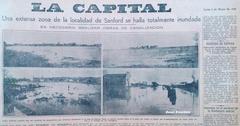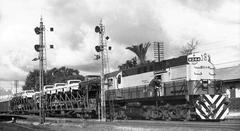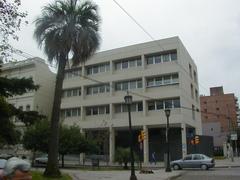Rosario Oeste Train Station: Visiting Hours, Tickets, and Travel Guide
Date: 04/07/2025
Overview
Rosario Oeste Train Station is a landmark of Argentina’s rich railway history and Rosario’s industrial evolution. Located in western Rosario, Santa Fe Province, the station—originally “Kilómetro 302”—was established in 1917 to serve as a bypass for trains heading to Córdoba, avoiding the city center’s congestion. Over the years, Rosario Oeste became a crucial node in Argentina’s rail and export network, especially for agricultural products, and its modern rationalist architecture marks an era of mid-20th-century modernization.
While currently operating primarily as a freight terminal under Trenes Argentinos Cargas y Logística, Rosario Oeste remains a site of historical and architectural interest. This guide provides a comprehensive look at its legacy, visitor information, safety tips, and nearby attractions.
For official details, visitors can consult the Rosario city government, Trenes Argentinos, and Wikipedia.
Table of Contents
- Historical Development and Architecture
- Significance and Impact
- Visiting Rosario Oeste
- Practical Tips and FAQs
- Visual Highlights and Resources
- Summary Table
- References
Historical Development and Architecture
Early Origins
Rosario Oeste was inaugurated in 1917 as “Kilómetro 302” on the Córdoba Central Railway, designed to streamline westbound train traffic and avoid congested downtown tracks (Railway Wonders of the World).
Modernization and Renaming
After the Argentine government took over the Córdoba Central Railway in 1939, the station was renamed “Rosario Oeste.” In the 1940s, the original structure was replaced with a modern rationalist building, a stark contrast to the ornate European-inspired designs of other local stations (Wikipedia).
Nationalization and Centralization
By 1949, under President Juan Perón’s railway nationalization, Rosario Oeste became the main terminal for meter-gauge long-distance trains, centralizing passenger and freight services and bolstering Rosario’s role as a major export hub (Railway Wonders of the World).
The Rosariazo Uprising
In 1969, during the Rosariazo uprising, the station was looted and set ablaze. It was the only Rosario station to be fully rebuilt after the unrest, highlighting its strategic value (Wikipedia).
Decline and Current Role
From the 1970s onwards, Argentina’s railway contraction reduced passenger services, shifting Rosario Oeste’s focus to freight. Today, it operates under Trenes Argentinos Cargas y Logística, serving routes to northern Argentina (Wikipedia).
Significance and Impact
Economic and National Role
Rosario Oeste played a pivotal part in transforming Rosario into Argentina’s “productive core.” The station enabled efficient transport of grains and oilseeds to the Rosario port, supporting a global export powerhouse (lacgeo.com; rosario.gob.ar). At its peak, the city’s port processed nearly half the nation’s grain and most of its soybean output.
As part of Argentina’s once-vast rail network (over 47,000 km by WWII), Rosario Oeste connected the city to major urban and rural centers, integrating local and national economies (en.wikipedia.org; rail.cc).
Social and Cultural Influence
The growth around Rosario Oeste fostered a multicultural community, with waves of European immigrants enriching the area’s social fabric. The neighborhood became a hub for labor activism and working-class culture, shaping Rosario’s progressive identity (lacgeo.com).
Urban Connectivity and Revitalization
Strategically located, Rosario Oeste links western neighborhoods to the center and port, supporting Rosario’s multi-centered urban structure. Modernization projects aim to better integrate rail with sustainable urban mobility (en.wikipedia.org).
Visiting Rosario Oeste
Location and Accessibility
Rosario Oeste is situated at Paraná and 9 de Julio streets, about 4 km west of downtown (everything.explained.today). It is accessible by car, taxi, or public bus—though taxis and ride-shares are preferable for unfamiliar visitors (travelerbibles.com).
Visiting Hours
- Current Status: No regular passenger services.
- Public Access: The exterior can be viewed during daylight hours. Interior access is restricted due to ongoing freight operations (ipfs.desmos.network).
- Events: Open during special cultural events or guided tours—check Rosario.gob.ar for updates.
Ticketing and Access
- Tickets: Not sold at Rosario Oeste, as there are no passenger services. For rail tickets, use Trenes Argentinos or Rosario Norte station.
- Entry: Free during cultural events; otherwise, explore the exterior freely.
Facilities and Services
- Freight-focused infrastructure, minimal public amenities.
- No waiting rooms, food vendors, or ticket offices.
- Restrooms may be present but are not consistently maintained (everything.explained.today).
Accessibility
- The station is not adapted for disabilities; no ramps, elevators, or accessible restrooms. Plan accordingly if you have mobility needs (ipfs.desmos.network).
Safety Considerations
- Neighborhood: Barrio Oeste is higher risk than central Rosario (travelerbibles.com; travelsafe-abroad.com).
- Tips:
- Visit during daylight.
- Avoid displaying valuables.
- Use taxis or ride-shares.
- Inform someone of your visit plans.
Nearby Attractions
- National Flag Memorial: Argentina’s monument to its flag and independence.
- Mercado del Patio: Vibrant food market.
- Riverfront Parks: Green spaces for relaxation.
- Island of Inventions (La Isla de los Inventos): Creative center in another historic station (My Adventures Across the World).
- Boulevard Oroño: Picturesque avenue for strolling.
Photography and Heritage Visits
- The rationalist architecture and industrial yards are ideal for photography (exterior only; request permission for operational areas).
- No scheduled guided tours, but check with local heritage groups for possible arrangements.
Practical Tips and FAQs
Practical Tips
- Best Time: Daytime, weekdays for safety and activity.
- Guided Visits: Occasional, especially during heritage events (official municipal website).
- Weather: Summers are hot/humid; winters are mild—dress accordingly (travelsafe-abroad.com).
FAQs
Q: Are there passenger train services at Rosario Oeste?
A: No, only freight operations as of July 2025.
Q: Can I buy tickets at the station?
A: No tickets are sold at Rosario Oeste.
Q: Is the station accessible for people with disabilities?
A: No; accessibility features are lacking.
Q: Are guided tours available?
A: Occasionally during cultural events. Check local listings.
Q: Is it safe to visit?
A: Safer during daylight; avoid visiting alone or after dark.
Q: What attractions are nearby?
A: National Flag Memorial, Mercado del Patio, riverfront parks, and Boulevard Oroño.
Visual Highlights and Resources
- Historic station images and architecture (Wikimedia Commons)
- Interactive maps and photos
- City tourism resources
Summary Table: Key Practical Information
| Aspect | Details |
|---|---|
| Location | Paraná & 9 de Julio, Barrio Oeste, Rosario |
| Use | Freight station (no passenger services) |
| Operator | Trenes Argentinos Cargas y Logística |
| Accessibility | Limited; not adapted for disabilities |
| Safety | Visit in daylight; use taxis/ride-shares; avoid valuables |
| Facilities | Minimal; no ticketing, food, or waiting areas |
| Photography | Exterior only; permission needed for operational areas |
| Emergency Numbers | Police: 911; Medical: 107; Fire: 100 |
| Language | Spanish |
| Nearby Attractions | City center (4 km), museums, parks, riverfront, Mercado del Patio |
References
- Rosario Oeste railway station, Wikipedia
- Railway Wonders of the World
- lacgeo.com
- Rosario city government
- everything.explained.today
- Trenopedia
- Wikimedia Commons
- travelerbibles.com
- travelsafe-abroad.com
- My Adventures Across the World
Plan Your Visit
Rosario Oeste Train Station is a testament to the city’s industrial and cultural legacy. While not an active passenger terminal, it offers architectural intrigue and a window into Argentina’s railway past. For the best experience, plan your visit during daylight, pair it with nearby attractions, and consult official sources for event schedules and updates.
Download the Audiala app for real-time travel info, guided tours, and updates on Rosario’s historical sites. Stay connected by following our social channels for the latest news and travel tips.






